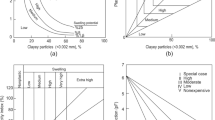Abstract
Swelling soils which cause problems in geotechnical engineering necessitate their determination and taking convenient cautions before design studies. Determination of swelling soils by indirect methods is mostly preferred due to its quick and economical aspects. One of the most common used indirect methods of determining swelling soils is the swell potential chart proposed by Van Der Merwe. However, because of the factors affecting plasticity index and clay fraction values, some uncertainties can arise in classification of swelling soils when using this approach. The uncertainty level reaches its maximum when the evaluation points on the chart fall on the lines that separate certain classes or very close to these lines. In this study, a fuzzy classification process for the Van Der Merwe method was suggested in order to minimize these uncertainties. For the purpose of the study, the spatial distances of the points from the lines were taken into consideration. Fuzzy swell potential classes were obtained by using sigmoid functions and fuzzy operators. The suggested method was applied on a set of data acquired from the laboratory and the results were discussed at the end of the study.






Similar content being viewed by others
References
Abduljauwad SN, Al-Sulaimani GJ (1993) Determination of swell potential of Al-Qatif clay. Geotechnical Testing Journal 16(4):469–484.
Aksoy H, Ercanoğlu M (2006) Fuzzified kinematic analysis of discontinuity-controlled rock slope instabilities. Eng Geol 89:206–219
ASTM (2015) ASTM D4318-10e1, Standard test methods for liquid limit, plastic limit, and plasticity index of soils. American Society for Testing and Materials, West Conshohocken
ASTM D422-63 (1998) Standard test method for particle-size analysis of soils. American Society for Testing and Materials, West Conshohocken
Badenhorst W, Theron E, Stott P (2015) Duplicate testing conducted on the input parameters for the estimation of potential expansiveness of clay. 16Th African Regional Conference on Soil Mechanics and Geotechnical Engineering, Volume: Innovative Geotechnics for Africa - Bouassida, Khemakhem & Haffoudhi (Eds)
Dakshanamurthy V, Raman V (1973) A simple method of identifying an expansive soil. Japanese Society of Soil Mechanics and Foundation Engineering 13(1):97–104
Elbadry H (2017) Simplified reliable prediction method for determining the volume change of expansive soils based on simply physical tests. Housing and Building National Research Center Journal 13(3):353–360
Gokceoglu C (2002) A fuzzy triangular chart to predict the uniaxial compressive strength of the Ankara agglomerates from their petrographic composition. Eng Geol 66:39–51
Grima NLA, Babuska R (1999) Fuzzy model for the prediction of unconfined compressive strength of rock samples. International Journal of Rock Mechanics and Mining Science 36:339–349
Haigh SK (2012) Mechanics of the Casagrande liquid limit test. Can Geotech J 49:1015–1023
Jones GA (2017) An empirical preliminary prediction of heave. J South Afr Inst Civil Eng 59(4):64–66
Khedemi F, Budiman J (2016) Expansive soil: causes and treatments. I-manager’s Journal on Civil Engineering 6(3):1–13
Kıyak A, Ergüven H, Karavul C (2007) Zemin sınıflamasında bulanık mantık uygulaması. Uluslararası Deprem Sempozyumu, Kocaeli, pp 573–577
Lee LT, Freeman RB (2007) An alternative test method for assessing consistency limits. Geotech Test J 30:1–8
Lu N, Ristow GH, Likos WJ (2000) The accuracy of hydrometer analysis for fine-grained clay particles. Geotech Test J 23(4):487–495
McKeen RG (1992) A model for predicting expansive soil behaviour. Proceedings. 7th International Conference on Expansive Soils, Dallas, pp 1–6
Mishra DA, Basu A (2013) Estimation of uniaxial compressive strength of rock materials by index tests using regression analysis and fuzzy inference system. Eng Geol 160:54–68
Negnevitsky M (2002) Artifical İntelligence: a guide to intelligent systems. Addison Wesley, London
Nguyen VU (1985) Some fuzzy set applications in mining geomechanics. International Journal of Rock Mechanics and Mining Science and Geomechanic Abstracts 22(6):369–379
Sakurai S, Shimizu N (1987) Assessment of rock slope stability by fuzzy set theory. ISRM Symposium on Rock Mechanics. A.A. Balkema, pp 503–506
Savage PF (2007) Evaluation of possible swelling potential of soils. Proceedings of the 26th Southern African Transport Conference, Pretoria, South Africa
Seed HB, Woodward RJ, Lundgren R (1962) Prediction of swelling potential for compacted clays. Proc., A.S.C.E.J. of Soil Mech. and Found. Div 88, pp 53–87
Sivakumar V, Glynn D, Cairns P, Black JA (2009) A new method of measuring plastic limit of fine materials. Geotechnique 59:813–823
Skempton AW (1953) The colloidal activity of clays. 3rd International Conference Soil Mech found Eng. Switzerland, vol 1
Stanciu A, Aniculaesi M, Lungu I (2013) Soil chart new evaluation method of the swelling-shrinkage potential, applied to the Bahlui’s clay stabilized with cement. Proceedings of the 18th International Conference on Soil Mechanics and Geotechnical Engineering, Paris, France, pp 1191–1194
Toksoz D, Yilmaz I, Hefeslioglu HA, Marschalko M (2016) A fuzzy classification routine for fine grained soils. Q J Eng Geol Hydrogeol 49(4):344–349
Uzuner BA (2007) Çözümlü problemlerle temel zemin mekaniği, Derya Kitabevi, 560 s. Trabzon
Van der Merwe DM (1964) The prediction of heave from the plasticity index and percentage clay fraction of soils. The Civil Engineer in South Africa 6(6):103–107
Wang JX (2016) Expansive soils and practice in foundation engineering. Louisiana Transportation Conference, Baton Rouge
Yıldırım E, Doğan E, Karavul C, Aşçı M, Özçep F, Arman H (2007) Bulanık mantık modeli ile zeminlerin sınıflandırılması. Uluslararası Deprem Sempozyumu, Kocaeli, pp 578–582
Zadeh LA (1965) Fuzzy sets. Inf Control 8:338–353
Author information
Authors and Affiliations
Corresponding author
Additional information
Responsible Editor: Zeynal Abiddin Erguler
Rights and permissions
About this article
Cite this article
Toksoz, D., Yilmaz, I. A fuzzy prediction approach for swell potential of soils. Arab J Geosci 12, 728 (2019). https://doi.org/10.1007/s12517-019-4938-3
Received:
Accepted:
Published:
DOI: https://doi.org/10.1007/s12517-019-4938-3




